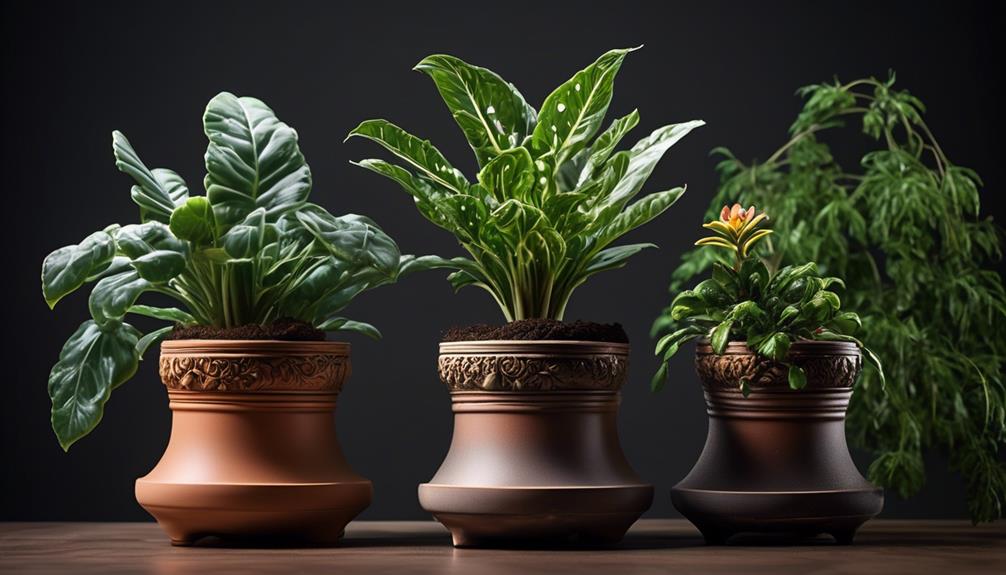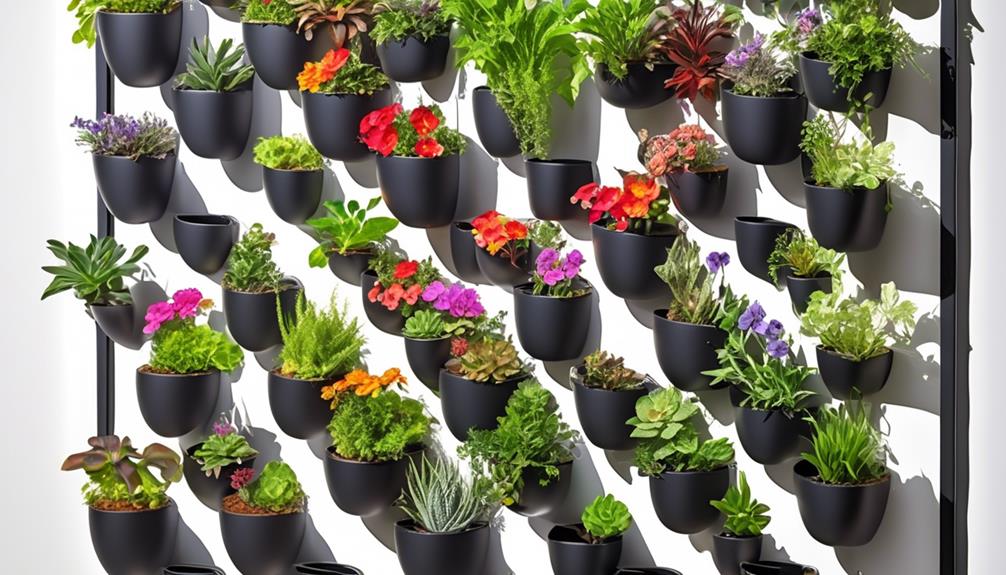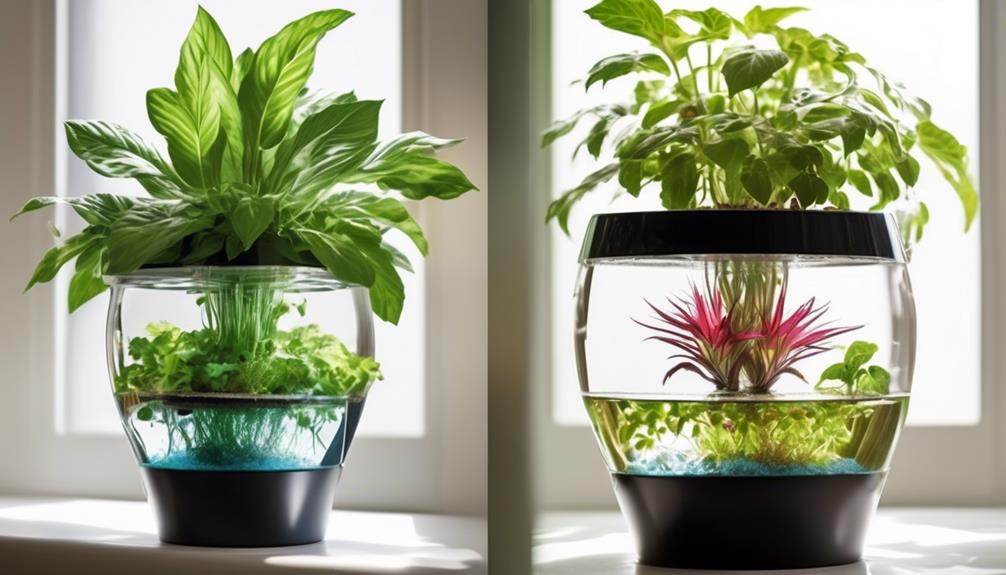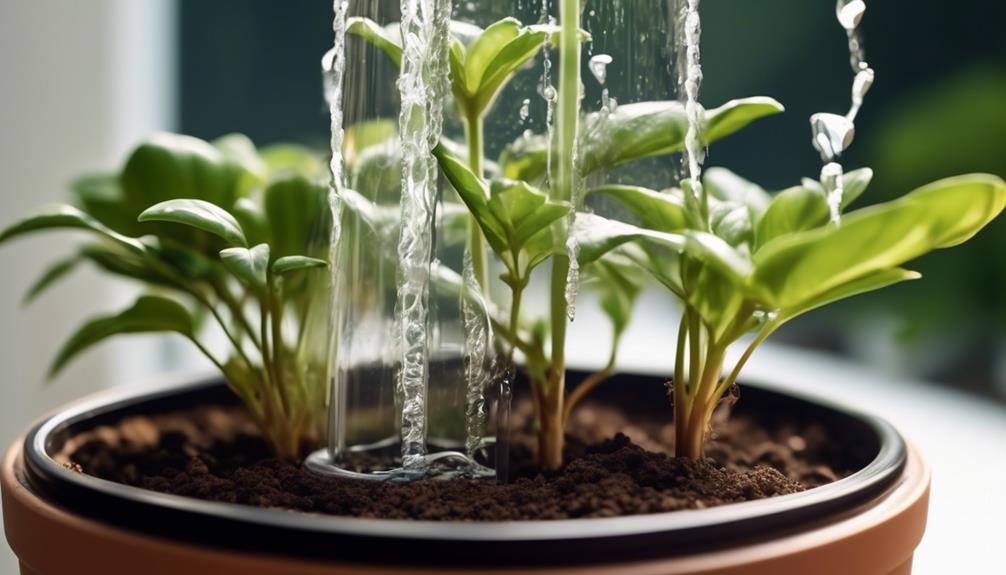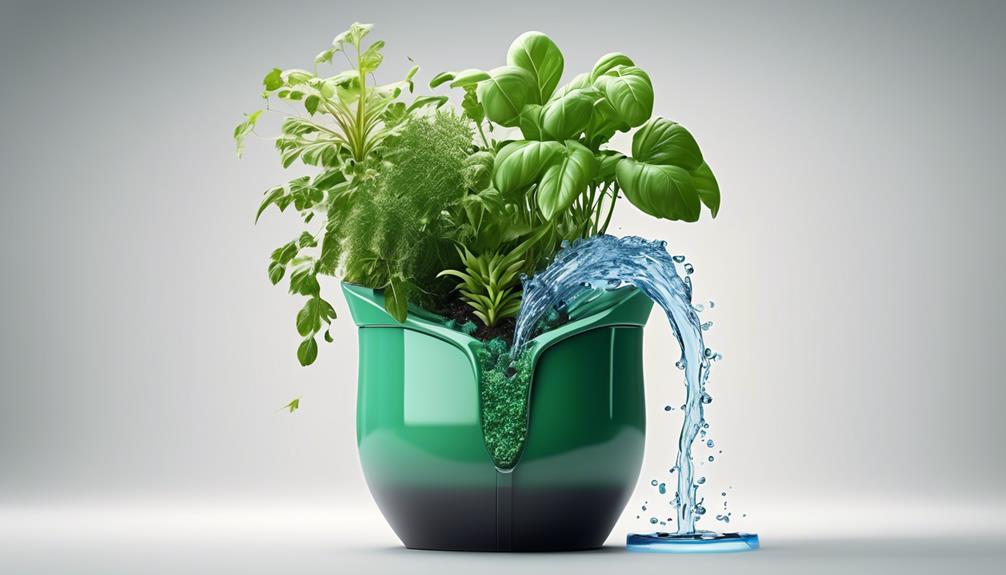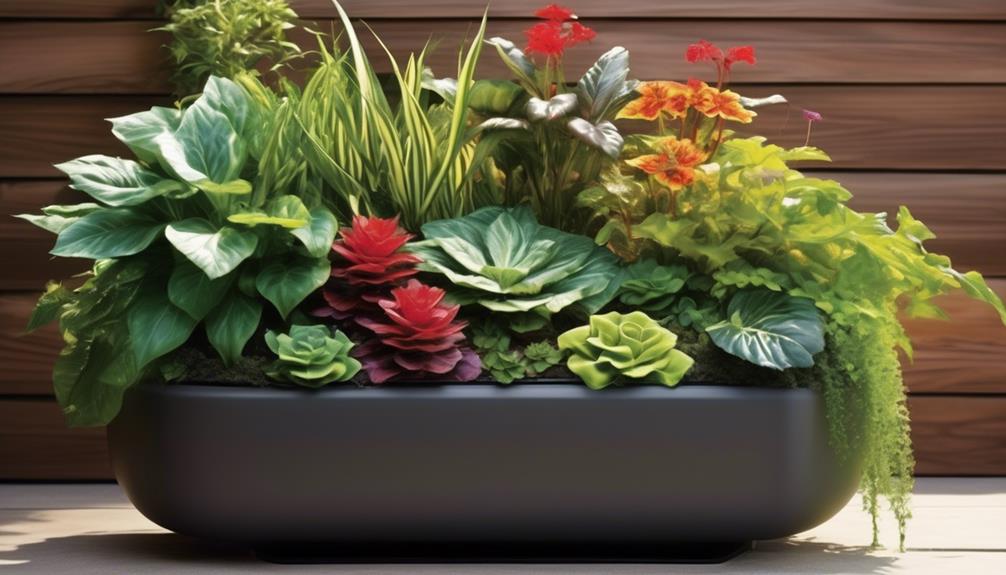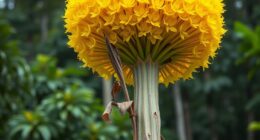We are all familiar with the constant challenge of caring for our beloved indoor plants, always worried about whether they are getting enough water to thrive.
But are self-watering plant pots the ultimate solution to this common dilemma? Let's explore the pros and cons of these innovative pots and whether they truly live up to the hype.
Key Takeaways
- Self-watering pots regulate watering to prevent both underwatering and overwatering.
- They promote healthier root development by providing consistent moisture levels.
- Self-watering pots utilize water reservoir technology to store excess water for later use.
- The capillary action mechanism in self-watering pots efficiently delivers moisture to the soil while reducing the risk of over or under watering.
Understanding Self-Watering Pots
Self-watering pots are designed to provide plants with a consistent and controlled water supply, reducing the need for frequent manual watering. Understanding the benefits and drawbacks of self-watering pots is crucial for maintaining optimal plant health.
The main benefit is their ability to regulate watering, preventing both underwatering and overwatering. This not only saves time but also promotes healthier root development. However, it's important to be aware of potential drawbacks, such as the possibility of water stagnation, which can lead to root rot if not managed properly.
When considering self-watering pots, DIY options are available for those who prefer a hands-on approach. These can range from simple, homemade systems to more complex designs. It's essential to understand the dynamics of these systems to ensure they effectively meet the plant's watering needs.
Watering frequency is another crucial aspect. While self-watering pots can extend the time between waterings, it's still important to monitor the soil moisture and adjust as necessary based on the specific requirements of the plant.
How Self-Watering Pots Work

Self-watering pots work through water reservoir technology. Excess water is stored for later use, allowing for a capillary action mechanism to take place. This mechanism draws water up into the soil as needed. As a result, plants are able to maintain hydration more efficiently. This technology also helps in reducing the risk of over or under watering.
Water Reservoir Technology
Occasionally, water reservoir technology in plant pots enables efficient and consistent moisture distribution, promoting healthier plant growth. This technology works by utilizing a reservoir at the bottom of the pot, separated from the soil by a water-permeable barrier. The soil and plant roots draw water from this reservoir as needed, ensuring a steady supply of moisture and preventing overwatering.
Capillary action and osmosis also play a role in delivering water to the soil. As the soil dries out, it creates a negative pressure, prompting water from the reservoir to move upwards and hydrate the soil. This process allows for better moisture control and reduces the frequency of manual watering, making it an efficient and practical solution for maintaining optimal soil moisture levels.
Understanding the mechanisms behind this watering technology is crucial for effectively utilizing self-watering pots.
Capillary Action Mechanism
Utilizing a capillary action mechanism, self-watering pots efficiently deliver moisture to the soil as needed, promoting optimal plant hydration and growth.
Capillary action, a fundamental principle in gardening and science, involves the movement of water through narrow spaces, such as the soil and the wick of a self-watering pot, due to the forces of adhesion and cohesion.
This mechanism ensures that the soil maintains consistent moisture levels, preventing both overwatering and underwatering.
The benefits of capillary action include reducing the frequency of watering, preventing water wastage, and providing a more stable environment for plant roots.
However, drawbacks may arise if the wick becomes clogged or if the reservoir isn't properly maintained, leading to potential soil saturation.
Understanding the principles of capillary action is crucial for effectively harnessing the benefits of self-watering pots in promoting healthy plant growth.
Plant Hydration Efficiency
Understanding the capillary action mechanism is fundamental to comprehending how self-watering pots efficiently deliver moisture to the soil, promoting optimal plant hydration and growth.
Self-watering pots utilize a system of reservoirs and wicks to provide a consistent supply of water to the plant's roots. The reservoir at the bottom of the pot holds water, and the wick, usually made of fabric or other porous material, draws the water upward into the soil through capillary action. This ensures that the soil maintains a consistent level of moisture, preventing both overwatering and underwatering.
The efficient delivery of water to the plant's roots promotes healthy growth and minimizes water wastage. This innovative watering technology is a practical solution for maintaining plant hydration, especially for individuals seeking a low-maintenance approach to gardening.
Benefits of Self-Watering Pots
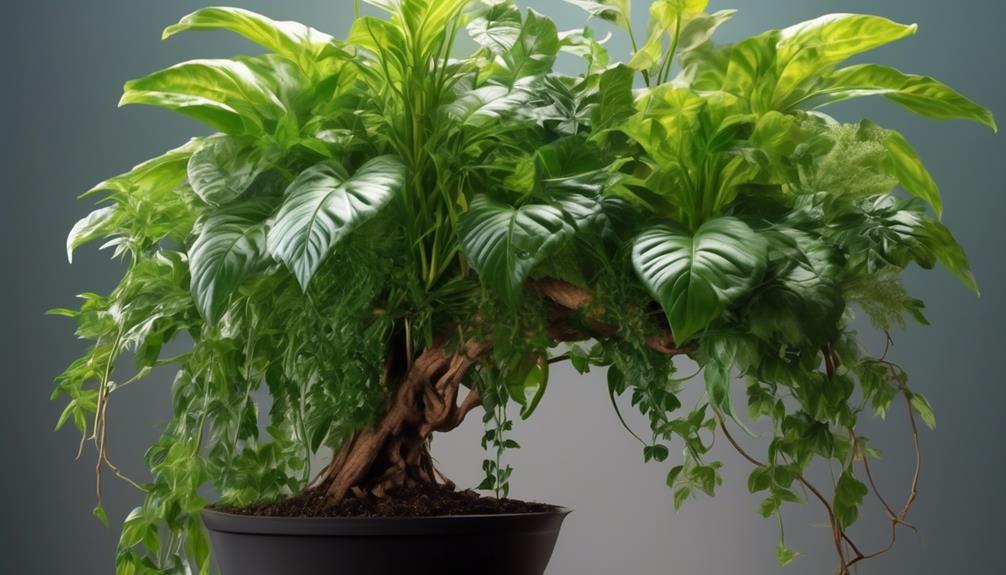
We've found that self-watering pots offer several benefits worth considering.
Firstly, they promote water conservation by minimizing water wastage through evaporation and runoff.
Secondly, these pots contribute to the overall health of plants by providing a consistent water supply, preventing under or overwatering.
Lastly, the convenience of self-watering pots allows for less frequent watering, making them a practical choice for busy individuals or those new to gardening.
Water Conservation
Self-watering pots offer an efficient way to conserve water while maintaining healthy plants. This innovative approach to watering automation not only benefits our plants but also has a positive environmental impact. Here are four key ways self-watering pots contribute to water conservation:
- Reduced Water Waste: Self-watering pots deliver water directly to the plant's roots, minimizing evaporation and runoff.
- Optimized Water Usage: Water saving technology in self-watering pots ensures that plants receive the precise amount of water they need, promoting sustainable gardening practices.
- Consistent Moisture Levels: By maintaining consistent moisture levels, self-watering pots prevent overwatering and underwatering, ensuring efficient water usage.
- Less Frequent Watering: Self-watering pots require less frequent watering, reducing overall water consumption while promoting plant health.
Incorporating self-watering pots into gardening practices can significantly contribute to water conservation efforts while nurturing thriving plants.
Plant Health
Using self-watering pots can significantly improve the overall health and vitality of your plants. These pots provide consistent soil moisture, which is essential for robust plant growth. By maintaining optimal moisture levels, self-watering pots help prevent issues such as overwatering or underwatering, which can stress plants and hinder their development.
When soil moisture is consistently balanced, plants can efficiently absorb nutrients and water, promoting healthy root systems and vigorous growth. Additionally, the controlled moisture levels in self-watering pots create a stable environment for beneficial soil microorganisms, further enhancing plant health.
Convenience
Maintaining consistent soil moisture levels isn't only beneficial for plant health but also contributes to the convenience of using self-watering pots. Here are four ways self-watering pots offer convenience:
- Watering automation: Self-watering pots automate the watering process, ensuring that plants receive consistent moisture levels without the need for frequent manual watering.
- Time-saving: Self-watering pots reduce the frequency of watering, saving time and effort, especially for individuals with busy schedules or those who travel frequently.
- Enhanced plant care: These pots help in maintaining optimal moisture levels, promoting healthier root development and overall plant growth.
- Efficient gardening techniques: Self-watering pots utilize efficient watering techniques, minimizing water wastage and reducing the risk of overwatering or underwatering plants.
Self-watering pots offer a practical solution for plant care, making gardening more convenient and efficient.
Drawbacks of Self-Watering Pots
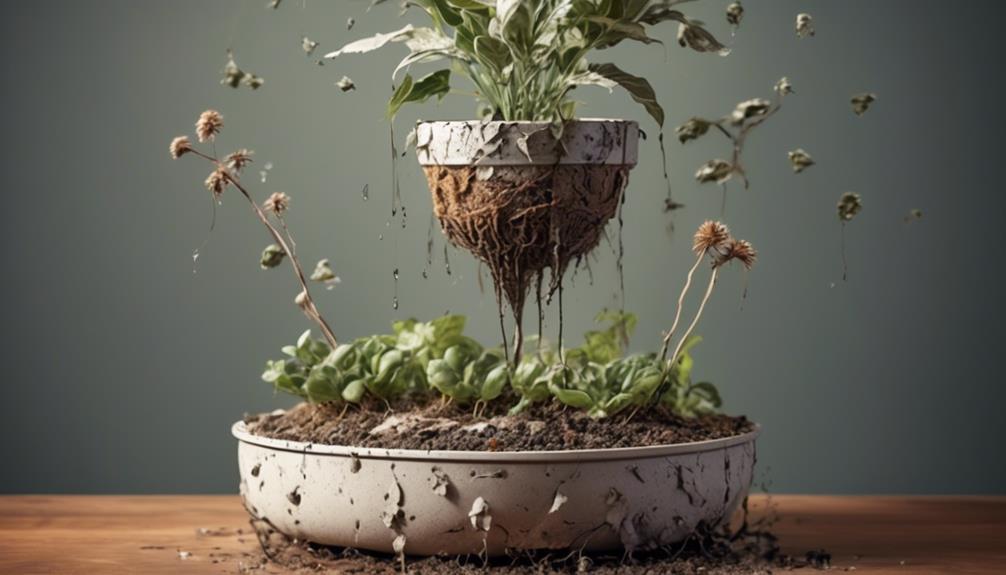
While self-watering pots offer convenience and water-saving benefits, some drawbacks should be considered when using them for plant cultivation. One of the main drawbacks of self-watering pots is the potential for overwatering. The reservoir at the bottom of the pot can lead to waterlogged soil if not managed properly, which can cause root rot and other issues. Additionally, some plants may not thrive in a self-watering pot environment, as they prefer a more traditional watering schedule.
Maintenance issues are also a concern with self-watering pots. The reservoir needs to be regularly cleaned to prevent the buildup of algae, bacteria, and mold, which can harm plant health. Furthermore, checking the water levels and refilling the reservoir can become a chore, especially for individuals with many plants.
It's important to carefully consider these drawbacks and maintenance issues before investing in self-watering pots for your plants. While they offer convenience, they may not be suitable for all plant varieties and require consistent attention to prevent potential problems.
Choosing the Right Self-Watering Pot
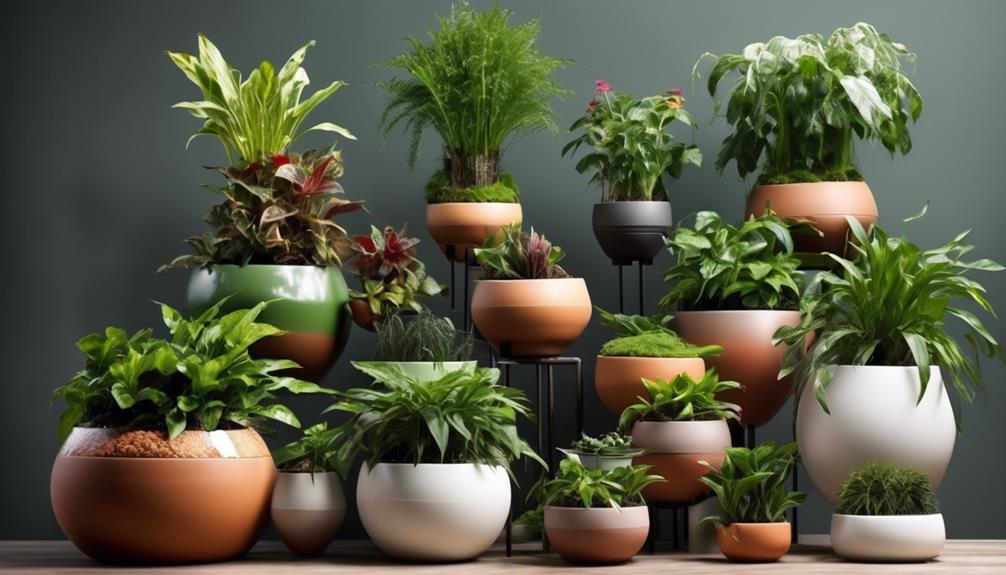
When selecting a self-watering pot, consider the specific watering needs and preferences of the plant species you intend to cultivate. This is crucial as different plants have varying water requirements, and choosing the right pot can significantly impact their growth and health.
Here are some key factors to consider:
- Choosing Size: Ensure the self-watering pot is appropriately sized for your plant. The pot should accommodate the plant's root system while leaving some room for growth. If the pot is too large, it can lead to overwatering, while a small pot may cause water stress for the plant.
- Material Options: Self-watering pots come in various materials such as plastic, ceramic, and terracotta. Each material has its advantages; for instance, terracotta allows for better air circulation, while plastic retains moisture more effectively. Consider the specific needs of your plant and the environment where the pot will be placed to make an informed choice.
- Aesthetic Appeal: While functionality is essential, the pot's appearance should also be considered. Choose a pot that complements the plant and the surrounding décor.
- Ease of Maintenance: Look for self-watering pots that are easy to clean and maintain. Consider features such as removable water reservoirs for convenient refilling and cleaning.
Self-Watering Pots for Indoor Plants
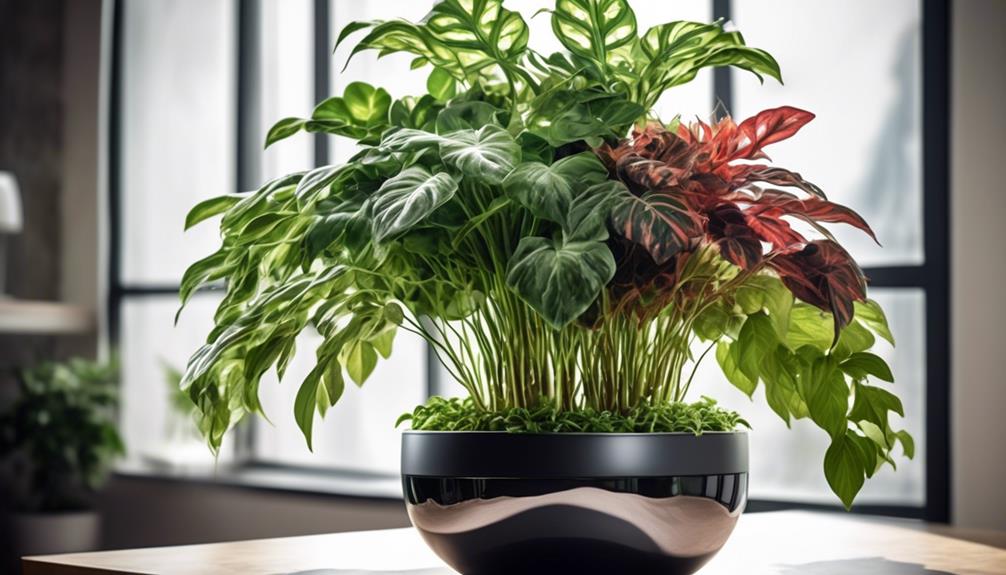
Self-watering pots for indoor plants provide a convenient and efficient way to ensure consistent moisture levels, promoting healthy growth and reducing the need for frequent watering. These pots are designed with water reservoirs, typically located at the bottom, which allow the plant to draw up water as needed. This mechanism helps in maintaining optimal plant hydration, preventing both under and overwatering, which are common issues in traditional pots.
The water reservoir in self-watering pots is separated from the soil by a wicking system, such as a wick or soil column, which draws water upward through capillary action. This ensures that the plant roots have access to water without becoming waterlogged. By maintaining a consistent moisture level, self-watering pots create an ideal environment for indoor plants to thrive.
For indoor plant enthusiasts seeking a low-maintenance and reliable watering solution, self-watering pots are a practical choice. They provide a buffer against underwatering during busy periods and prevent waterlogging, which can lead to root rot. With the convenience and effectiveness of self-watering pots, plant care becomes more manageable, allowing enthusiasts to focus on enjoying healthy, vibrant indoor greenery.
Self-Watering Pots for Outdoor Plants
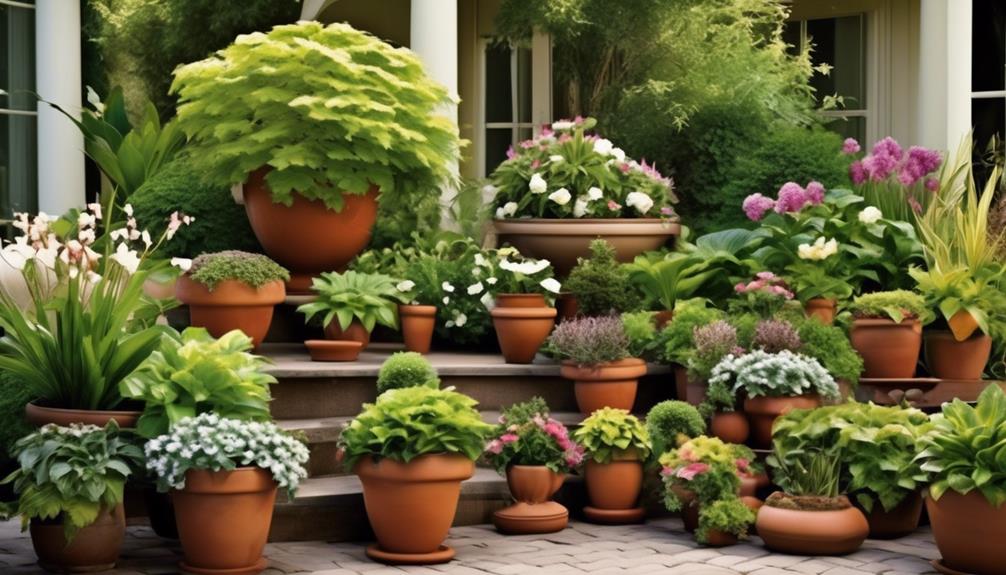
Outdoor plants benefit from the use of self-watering pots due to their ability to provide consistent moisture levels and reduce the frequency of manual watering. As a result, outdoor plant maintenance becomes more manageable, and the plants thrive with minimal effort.
Here are four benefits of using self-watering pots for outdoor plants:
- Consistent Moisture: Self-watering pots help maintain consistent moisture levels in the soil, ensuring that the plants receive water as needed, which is especially beneficial during hot summer days.
- Reduced Watering Frequency: With self-watering pots, the need for manual watering is significantly reduced, making it convenient for individuals with busy schedules or those who may forget to water their outdoor plants regularly.
- Prevention of Water Stress: These pots prevent outdoor plants from experiencing water stress, as they supply water directly to the roots, promoting healthy growth and minimizing the risk of wilting.
- Enhanced Plant Health: By providing a more stable environment for the plants, self-watering pots contribute to overall plant health and vitality, leading to better growth and blooming.
Are Self-Watering Pots Low Maintenance?
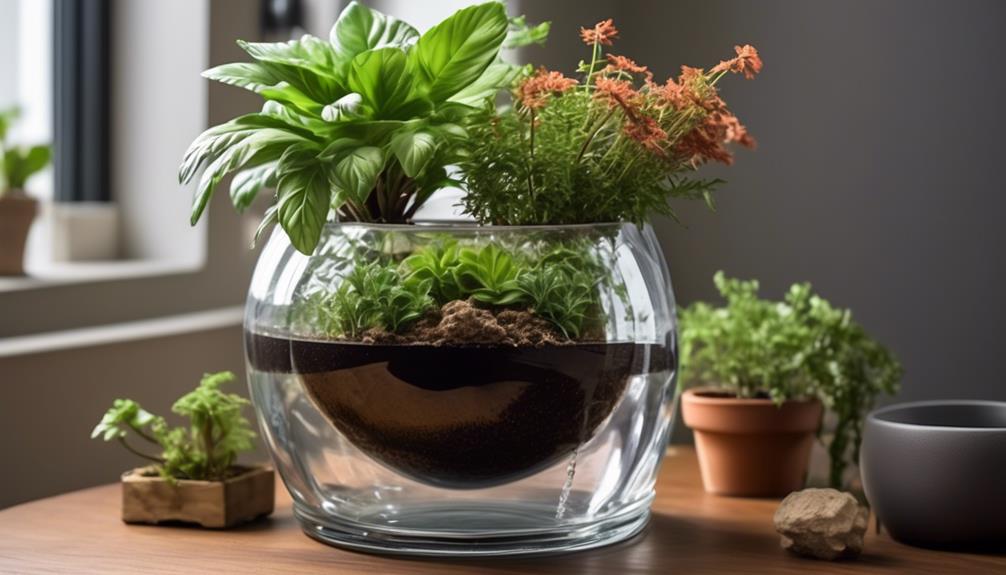
We've all experienced the challenge of maintaining consistent moisture levels in our plant pots, especially during busy periods. Self-watering pots offer a practical solution by reducing the frequency of watering required.
This not only saves time but also ensures that plants receive the consistent moisture they need for healthy growth.
Watering Frequency Reduced
With self-watering plant pots, the frequency of watering is significantly reduced, making them a low-maintenance option for plant care. This reduction in watering frequency is due to the watering automation system and the ability of the pots to maintain optimal soil moisture levels. Here's why the reduced watering frequency makes self-watering pots a practical choice:
- Consistent Moisture Levels: The self-watering mechanism ensures that the soil moisture remains consistently at the ideal level, reducing the need for frequent watering.
- Time Efficiency: With less frequent watering required, valuable time is saved, making self-watering pots an efficient choice for busy individuals.
- Reduced Risk of Overwatering: The self-watering system prevents overwatering, which is a common issue in traditional pots, promoting healthier plant growth.
- Low Maintenance: The reduced watering frequency makes self-watering pots a low-maintenance solution, ideal for those seeking hassle-free plant care.
Consistent Moisture Levels
Self-watering plant pots offer a practical solution for maintaining consistent moisture levels, contributing to their low-maintenance nature and promoting healthy plant growth.
The built-in reservoir system allows for efficient moisture regulation, ensuring that plants receive water as needed, reducing the risk of over or under-watering. This consistent moisture supply is essential for promoting optimal water retention in the soil, which is crucial for plant health.
By maintaining a balanced moisture level, self-watering pots create a stable environment for plants, reducing the need for constant monitoring and manual watering. As a result, plant owners can enjoy the convenience of low-maintenance care while providing an ideal growing environment for their green companions.
This consistent moisture regulation is a key factor in the overall effectiveness and practicality of self-watering plant pots.
Time-Saving and Efficient
Maintaining a consistent moisture level in self-watering plant pots not only promotes healthy plant growth but also contributes to their low-maintenance nature, making them time-saving and efficient for plant care. Here are four reasons why self-watering pots are a game-changer for time management and watering efficiency:
- Consistent Moisture: Self-watering pots provide a steady supply of water to the plant, reducing the need for frequent manual watering.
- Reduced Maintenance: These pots require less frequent watering, saving time and effort while ensuring the plants receive consistent moisture.
- Water Conservation: Self-watering pots minimize water wastage by delivering water directly to the plant's roots, promoting efficient water usage.
- Plant Health: By maintaining the right moisture levels, these pots support healthy plant growth, offering long-term gardening benefits.
With these advantages, self-watering pots are a practical and efficient choice for plant care, offering time-saving solutions and promoting healthy, thriving plants.
Do Self-Watering Pots Prevent Overwatering?
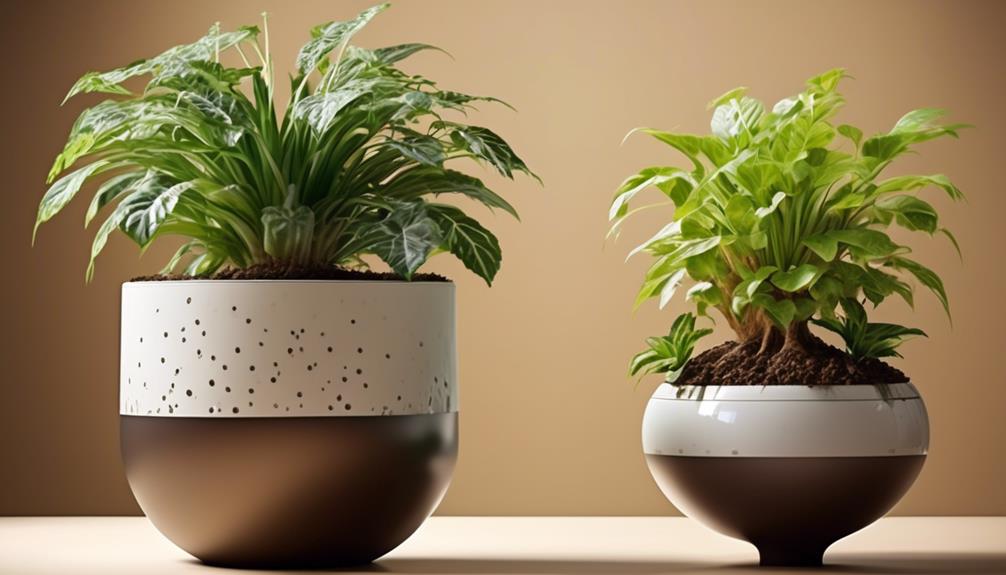
How can self-watering pots effectively prevent overwatering and promote healthy plant growth?
Self-watering pots are designed to prevent overwatering by providing optimal hydration efficiency for plants. These pots typically consist of a water reservoir at the bottom, which is separated from the soil by a wicking mechanism. This wicking mechanism allows the soil to draw up water as needed, ensuring that the plant receives just the right amount of moisture.
By maintaining a consistent level of moisture in the soil, self-watering pots help prevent overwatering, which is a common cause of root rot and other moisture-related issues.
The design of self-watering pots also promotes healthy plant growth by creating a self-regulating system. As the plant uses up the water in the soil, the wicking mechanism continues to supply water from the reservoir, ensuring that the plant never experiences drought stress. This consistent moisture level not only prevents overwatering but also encourages robust root development and overall plant health.
Additionally, self-watering pots reduce the frequency of watering, saving time and effort while providing an optimal growing environment for plants.
Can Self-Watering Pots Improve Plant Health?
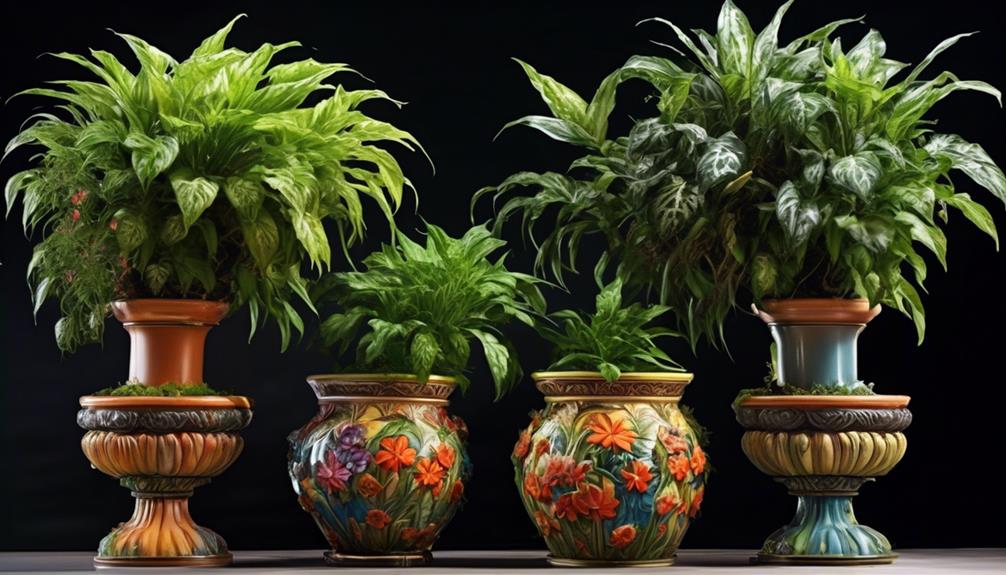
Improving plant health through consistent moisture regulation, self-watering pots offer a practical solution for maintaining optimal hydration levels. Self-watering pots can indeed improve plant health in various ways. Here are four key benefits:
- Optimal Hydration: Self-watering pots provide a consistent moisture level, ensuring plants receive the right amount of water at all times. This helps prevent underwatering or overwatering, which are common issues in traditional pots.
- Reduced Stress: With self-watering pots, plants are less prone to stress caused by fluctuations in soil moisture. Consistent hydration levels promote stable growth and minimize the risk of wilting or leaf damage.
- Enhanced Nutrient Uptake: Proper hydration is essential for nutrient absorption in plants. By maintaining consistent moisture, self-watering pots support improved uptake of essential nutrients, fostering healthier and more robust growth.
- Root Health: Consistent hydration provided by self-watering pots promotes strong and healthy root systems. This, in turn, enhances overall plant resilience and vitality.
Self-Watering Pots Vs. Traditional Pots

Self-watering pots offer a consistent moisture level, ensuring optimal hydration for plants, a contrast to the variable moisture levels in traditional pots. This difference impacts the overall health and growth of plants, making it essential to consider when choosing the right pot for your greenery. To better understand the disparities between these two pot types, let's compare their key attributes in the table below.
| Aspect | Self-Watering Pots | Traditional Pots |
|---|---|---|
| Watering Technique | Utilizes a reservoir system for self-watering | Requires manual watering based on plant needs |
| Moisture Consistency | Maintains consistent moisture levels | Moisture levels vary based on watering frequency |
| Root Health | Promotes healthy root growth | Risk of overwatering or underwatering |
| Convenience | Reduces frequency of watering maintenance | Regular monitoring and manual watering required |
| Plant Growth Potential | Supports optimal growth conditions | Growth may be impacted by inconsistent watering |
Understanding the differences between self-watering and traditional pots is crucial for effectively meeting the watering needs of your plants. While traditional pots offer flexibility in watering techniques, self-watering pots provide a more consistent and convenient approach to maintaining plant hydration.
Factors to Consider Before Buying Self-Watering Pots
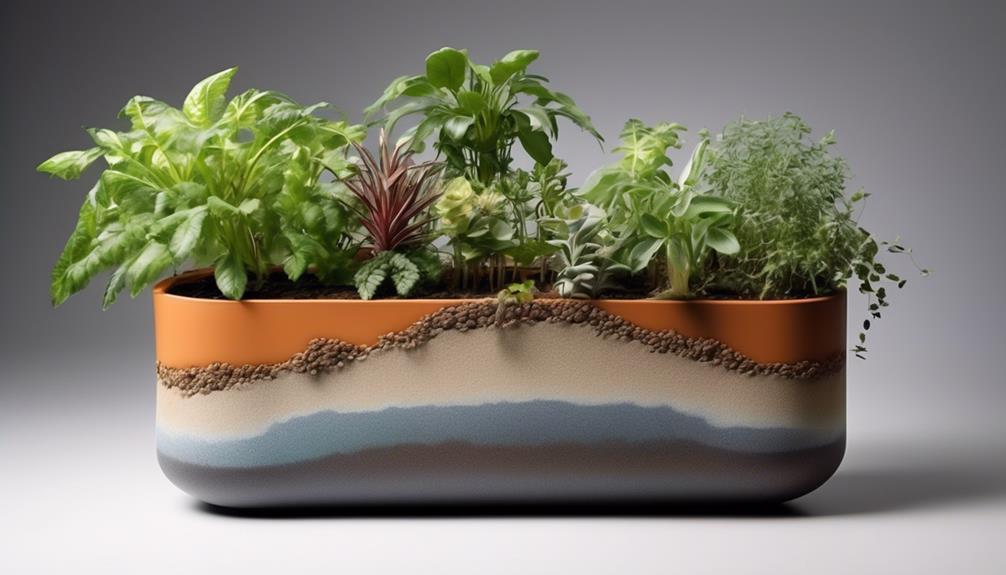
When considering the purchase of self-watering pots, it's essential to evaluate the specific needs of your plants and the environment in which they'll be placed. Here are some factors to consider before buying self-watering pots:
- Maintenance Requirements: Assess how much time and effort you're willing to dedicate to pot maintenance. Self-watering pots can reduce the frequency of watering, but they still require occasional monitoring and refilling of the water reservoir. Consider the size of the reservoir and how often it will need to be replenished based on your plant's water needs.
- Plant Growth Benefits: Research the specific plant species you intend to grow in self-watering pots. While these pots can provide a consistent water supply, not all plants thrive in continuously moist soil. Certain plants may benefit from the improved root aeration and regulated hydration provided by self-watering pots, while others may suffer from overwatering.
- Material and Durability: Evaluate the material of the self-watering pots to ensure it aligns with the needs of your plants and the environment. Consider factors such as insulation, UV resistance, and overall durability to make an informed decision.
- Size and Aesthetic: Choose a self-watering pot size that accommodates the growth of your plants and complements the aesthetic of the space. Ensure that the pot's design and size allow for healthy root development and overall plant growth.
DIY Self-Watering Pot Options
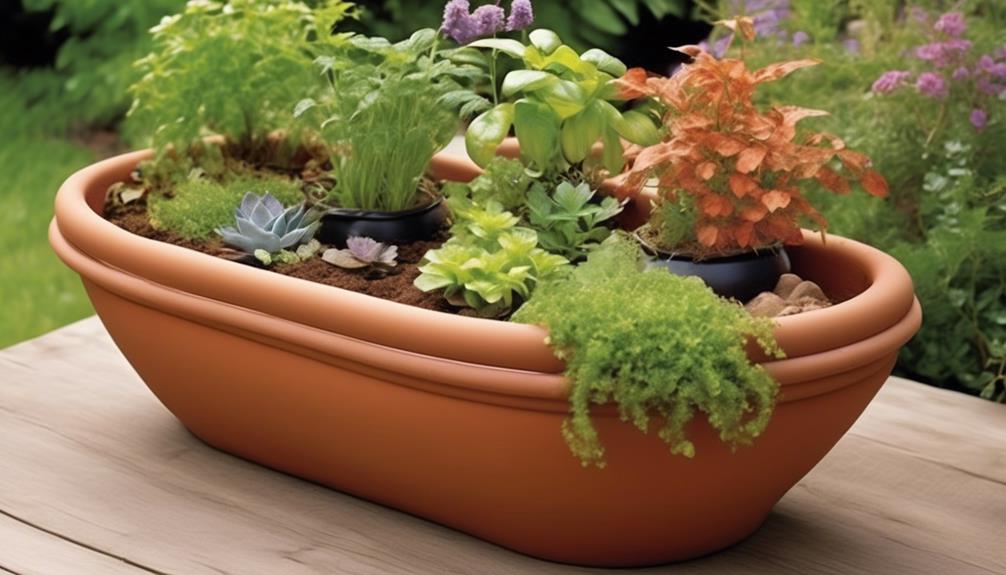
Considering the factors for plant growth benefits and maintenance requirements, exploring do-it-yourself (DIY) self-watering pot options can offer a practical and customizable solution for plant care.
When considering DIY self-watering pot materials, it's essential to choose a container that can hold the plant, soil, and water while allowing for proper drainage. Common materials include plastic storage containers, ceramic pots, or even recycled bottles. These materials are easily accessible and can be repurposed for self-watering pot designs.
When it comes to self-watering pot design options, the wicking system is a popular choice. This design utilizes a wick, such as a cotton string or felt fabric, to draw water from a reservoir into the soil, ensuring consistent moisture for the plant.
Another design option is the reservoir system, where a separate water reservoir is placed beneath the soil, allowing the plant to absorb water as needed.
Tips for Using Self-Watering Pots
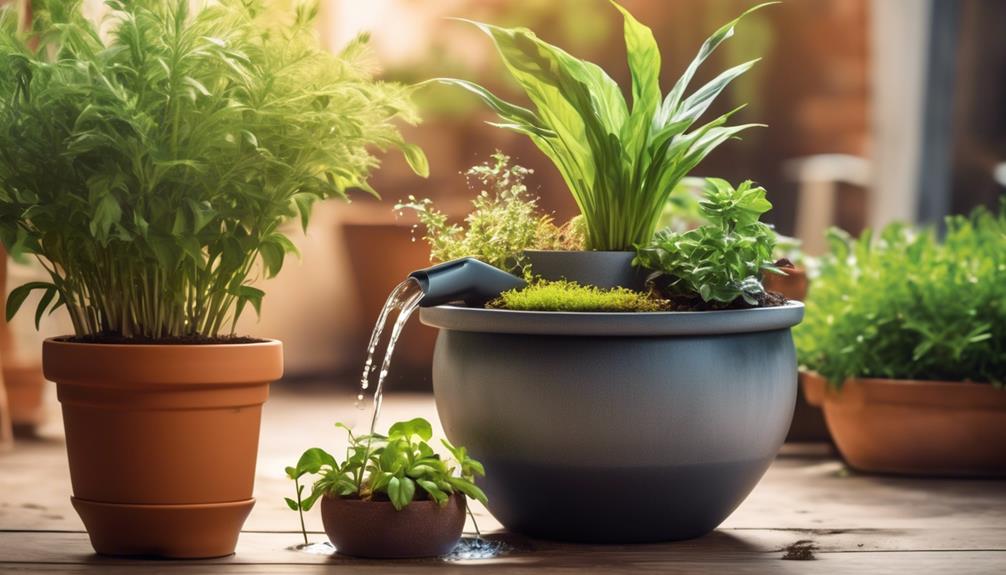
We've found that adjusting the watering frequency is essential when using self-watering pots.
It's important to monitor the moisture levels closely to ensure the health and vitality of the plants.
These simple tips can make a significant difference in the success of using self-watering pots for your plants.
Watering Frequency
To maintain optimal moisture levels in self-watering pots, it's important to monitor the soil moisture regularly and adjust the watering frequency accordingly. Here are some practical tips for managing watering frequency and promoting healthy plant growth:
- Check Soil Moisture: Regularly assess the soil moisture using a moisture meter or by simply sticking your finger into the soil. This helps in understanding the watering needs of the plants accurately.
- Observe Plant Growth: Monitor the growth of your plants. Increased growth or hotter weather may require more frequent watering, while slower growth or cooler conditions may necessitate less frequent watering.
- Adjust According to Season: During hot and dry seasons, plants may require more water, so adjust the watering frequency accordingly to prevent soil from drying out.
- Avoid Overwatering: Be cautious not to overwater, as this can lead to waterlogged soil and root rot. Adjusting the watering frequency helps in maintaining watering efficiency and promoting healthy plant growth.
Plant Health
When using self-watering pots, it's crucial to ensure proper plant health by implementing effective watering practices.
Plant health is directly influenced by the hydration technology employed in these pots. The self-watering mechanism provides consistent moisture to the plant's roots, promoting optimal hydration levels for sustained growth. This technology helps prevent issues such as overwatering or underwatering, which are common problems in traditional pots and can negatively impact plant health.
By maintaining a balanced moisture level, self-watering pots support robust plant growth and vitality. However, it's important to monitor the moisture levels to ensure they're suitable for the specific plant species.
Additionally, regular checks on the pot's water reservoir and proper maintenance of the watering system are essential for maximizing plant health in self-watering pots.
Frequently Asked Questions
Can Self-Watering Pots Be Used for All Types of Plants, Including Succulents and Cacti?
Yes, self-watering pots can be used for all types of plants, including succulents and cacti.
Succulent care requires less frequent watering, and self-watering pots can help regulate the moisture levels, preventing overwatering.
The pots provide a reservoir for water, allowing the plants to absorb moisture as needed.
This can be especially beneficial for succulents and cacti, as it mimics their natural environment and helps prevent root rot.
Are There Any Environmental Benefits to Using Self-Watering Pots?
Using self-watering pots reduces water waste, benefiting the environment and promoting water conservation.
These pots have an environmental impact by minimizing water usage through efficient irrigation systems. The design prevents over-watering, decreasing water runoff and promoting plant health.
Additionally, the water-saving feature reduces the overall environmental impact of traditional watering methods.
Do Self-Watering Pots Require a Specific Type of Soil or Fertilizer?
Self-watering pots are designed to work with a variety of soil types, but it's crucial to choose a well-draining mix. This allows the water to move freely to the plant's roots, preventing waterlogging.
When it comes to fertilizer, a balanced liquid fertilizer is often recommended for self-watering pots. This provides essential nutrients without the risk of overfeeding the plants.
Adhering to these guidelines can help optimize plant health and growth in self-watering pots.
Can Self-Watering Pots Be Used in Conjunction With Other Watering Methods, Such as Drip Irrigation?
Yes, self-watering pots can be used in conjunction with other watering methods, such as drip irrigation. This allows for flexibility in watering and ensures that plants receive the optimal amount of moisture.
Additionally, self-watering pots can be combined with hydroponic systems to provide a more efficient and consistent water supply.
This compatibility with traditional watering methods and combination with hydroponic systems makes self-watering pots a versatile option for plant care.
Are There Any Special Considerations for Using Self-Watering Pots in Extreme Weather Conditions, Such as High Temperatures or Heavy Rainfall?
In navigating extreme weather, self-watering pots demand careful attention. Special considerations must be made to ensure plant health in high temperatures or heavy rainfall. These conditions can impact the effectiveness of self-watering systems and the overall growth of plants.
It's crucial to monitor soil moisture levels and adjust watering schedules accordingly. Understanding the intricate relationship between extreme weather and self-watering pots is key to promoting optimal plant growth.
What Are the Benefits of Using Self-Watering Plant Pots?
Self watering pots for plants offer the convenience of watering plants less frequently. They provide a consistent water supply, preventing over or under watering. This helps plants to thrive, reducing the risk of root rot and allowing for healthier growth. Additionally, they are low-maintenance, making them ideal for busy individuals.
Conclusion
In conclusion, self-watering pots can be a great option for busy plant owners or those who struggle with regular watering. The convenience and water-saving benefits make them a practical choice for indoor and outdoor plants.
Just like a reliable friend who always has your back, self-watering pots can be the dependable support your plants need to thrive. With the right care and attention, these pots can help your greenery flourish with minimal effort.

